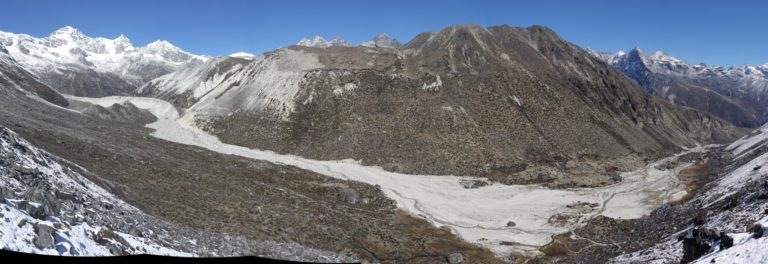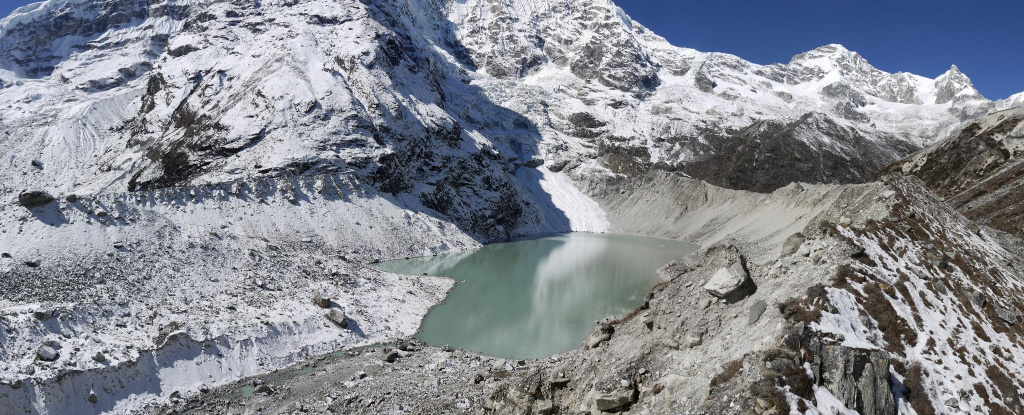Glaciers are melting, putting the lives of millions around the world at risk of flash flooding, according to a new study.
Most of those people reside in just four countries – India, Pakistan, Peru, and China – where glacial lakes are numerous and populations are vulnerable to climate disasters.
Glaciers are 'rivers of ice' that form over millions of years from compressed snow. They ooze ever so slowly down valleys and sometimes grow so big as to form ice sheets that extend out into the sea.
But with rising temperatures, glaciers are melting faster than scientists thought and around half of the world's 215,000 glaciers could vanish by the end of the century.
The impacts could be felt far, far sooner. In the same way that warm seawater upwelling from the depths can melt ice sheets from beneath, meltwater that pools beneath glaciers on land can accelerate ice loss.
Where that runoff accumulates in depressions left by retreating ice, deep lakes and fast-flowing rivers can form, rising and falling at the whim of ongoing ice loss.
This new study, led by natural hazards researcher Caroline Taylor of Newcastle University in the UK, estimates around 15 million people live downstream of a glacial lake that could burst.
Predicting when a glacial lake will actually overflow is very difficult though without detailed, on-the-ground studies.
Glacial lake outburst floods (GLOF) also often happen with little advanced warning, sweeping through townships, killing hundreds if not thousands of people, and wiping out any infrastructure in their path; a path of destruction that can stretch for over 120 kilometers (74.5 miles).
So Taylor and colleagues assessed the risk glacial lakes globally pose to people who live below them, to catalyze targeted risk management efforts to help those most in danger.

The Langmoche valley below Dig Tsho glacial lake in Nepal. (Matthew Westoby)
The researchers compiled information on the conditions of glacial lakes – which have been growing in size, number and volume over the past three decades – and about the communities who live downstream.
Risk can be tricky to compute but in this case, the researchers factored in the proximity of communities to a potential outburst (their exposure) and how likely they would be impacted if the lake burst (vulnerability) as of 2020. Political corruption was also noted, as this stymies recovery efforts.
According to the researchers, this is the first global study "that considers not just the physical lake conditions, but also societal exposure and vulnerability that directly influence GLOF danger."
The analysis showed that areas with the highest danger are not those with the largest, most numerous, or most rapidly growing glacial lakes, as you might expect. Rather, the number of people within the region and their capacity to cope with disaster is central to their risk.
Populations in the high mountainous regions of Asia are the most exposed, living closest to glacial lakes. Pakistan and China rank as the two countries most in danger globally.
Pakistan has 2.1 million people living in close proximity to glacial lakes at risk of overflowing – nearly twice that of China. China's glacial lakes are larger and more numerous though, so could do more damage to infrastructure.
Recently, the Himalayas have become a 'hotspot' of research into the potential impacts of swelling glacial lakes. But the researchers also singled out the Andes mountains in South America, and particularly Peru, which ranked third in terms of danger, as another area of concern.
Few research studies have been conducted in the Andes, and yet the number of glacial lakes across the region has increased by 93 percent over the past two decades (compared to just 37 percent in Asia). Deep-rooted corruption is also an issue.
"This data sparsity across the Andes is perhaps preventing meaningful assessments of actual GLOF risk in the region and urgently requires attention, particularly given the second- and third-most dangerous basins are found in this region," Taylor and colleagues write.
Although the researchers only looked at a snapshot in time, they say their methods could be used to monitor the danger from glacial lake outburst floods over time.
Communities are not sitting idle though. In 2015, Peruvian farmer and mountain guide Saúl Luciano Lliuya sued Germany's largest electricity provider, RWE, for the costs of safeguarding his hometown of Huaraz from the potential outburst flood from glacial Lake Palcacocha.
The landmark case is progressing, with German judges traveling to the region in 2022 to assess the level of potential damage to Huaraz from an outburst flood. The lake has swelled to be 34 times larger than it was in 1970 and rockfalls could soon trigger an overflow.
Proving in a legal sense that pollution emitted in Europe has caused a glacier in Peru to melt is not easily done. But scientifically, a 2021 peer-reviewed study asserted that greenhouse gas emissions have accelerated glacial melt and increased the risk of flood.
If Luciano Lliuya is successful in his case, it would propel other cases attempting to hold fossil fuel companies liable for their contributions to global climate change.
The research has been published in Nature Communications.
- alf9872000
-

 1
1



Recommended Comments
There are no comments to display.
Join the conversation
You can post now and register later. If you have an account, sign in now to post with your account.
Note: Your post will require moderator approval before it will be visible.